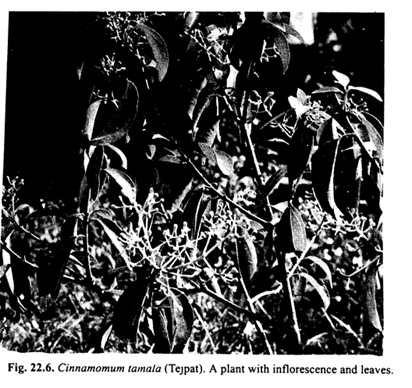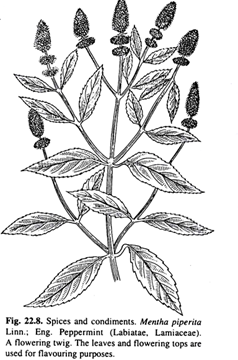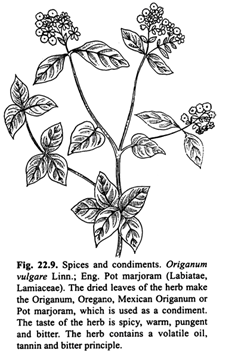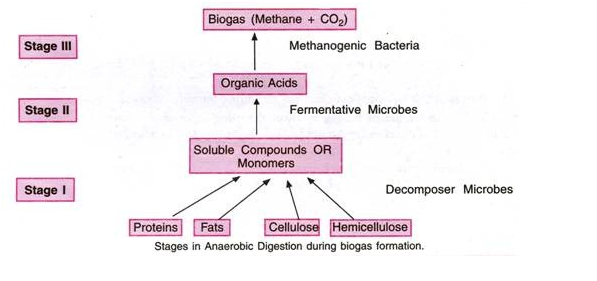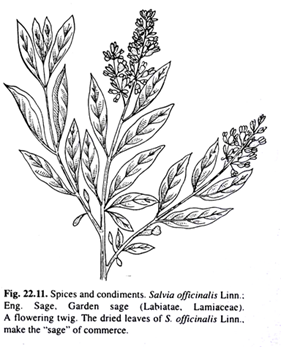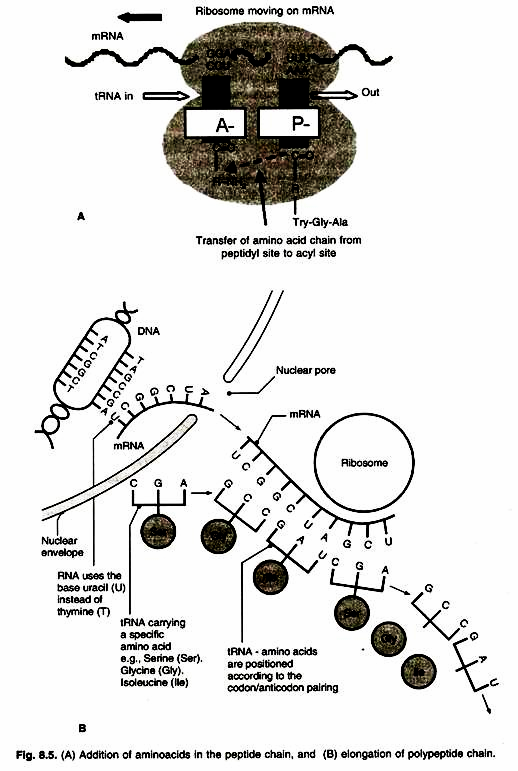The following points highlight the top twelve spices obtained from leaves and twigs. The spices are: 1. Indian Cassia 2. Sweet Marjoram 3. Field Mint 4. Mint 5. Peppermint 6. Spearmint 7. Curry Leaf Tree 8. Common Basil 9. Pot Marjoram 10. Rosemary 11. Garden Sage 12. Thyme.
Spice # 1. Indian Cassia:
Cinnamomum tamala (Buch.-Ham.) T. Nees & Eberm.; English—Indian Cassia; Hindi- Leaves = tejpat, tajpat, bark = taj kalami, dalchini, talispatri, silkanti; Bengali—Tejpaf, Nepali—Chota sinkoli; Assamese—Dopatti; Mumbai—Darchini, tamala-, Gujarati—Taj, tamalpatra; Marathi—Dalchini tiki; Tamil—Talisha-pattiri, Telugu—Tallisha-patri; Kannada— Lavanga patte; Sanskrit—Tamal, tespatra; Arabic—Zarnab; Family—Lauraceae.
A moderate-sized evergreen tree, found on the Himalayas, between 3,000 and 7,000 feet, in Bengal, the Khasia hills and Assam.
A cinnamon known as Indian Cassia is obtained from this plant. It is a coarser and sold in larger pieces than the true cinnamon or bark of C. zeylanicum Bl., for which it is often used as an adulterant. The bark of the root is quite as good as the true cinnamon bark. In Manipur, the natives collect the root-bark instead of the stem-bark.
Cassia Buds:
These are the immature fruits of tree yielding Indian Cassia. They are something like cloves, and consist of the unexpanded flower-heads. They possess properties similar to those of the bark. Cassia buds were once employed in preparing the speed wine called Hippocras.
Cassia Bark:
The bark has a general resemblance to cinnamon, but is in simple quills, not inserted one within the other. The quills are less straight, even and regular, and of dark-brown colour. It breaks with a short fracture.
Uses:
The leaves are known as tejpat, and bark as taj. The bark and dried leaves are used to flavour dishes. The leaves are commonly used as a condiment. They are famous for their pungency and added in cooked rice (pulao) and curries.
Leaves are also used medicinally. They are stimulant, carminative, used in rheumatism, colic, diarrhoea, and in scorpion sting. Bark is aromatic and used in gonorrhoea.
Leaves yield an essential oil, which contains d-phellandrene and 78% eugenol.
Spice # 2. Sweet Marjoram:
Majorana hortensis Moench; English— Sweet marjoram; Hindi—Murwa; Bengali—Murru; Kannada—Maruga; Malayalam—Maruvamw, Tamil—Marru; in Kumaon it is called Bantulsi and in Dakshin Bharat Murwa; Family—Labiatae (Lamiaceae).
This is an aromatic, branched perennial, 1-2 feet high. It is native of mediterranean region. North Africa and Asia Minor. The herb is commonly grown in Indian gardens. It is well suited for hilly places in India. Leaves oblong-ovate; flowers small, whitish or purplish, in terminal clusters; seeds minute, oval, dark brown.
It is treated as an annual under cultivation. It thrives well in well-drained fertile garden loam. It is propagated by seeds and cuttings. Seeds are sown in pots and seedlings, when large enough, are transplanted in the field 8-10″ apart in rows.
The crop becomes ready for harvesting in three and half months. The tops are cut when the plants are coming into flower and dried in the shade. The volatile oil content of leaves is maximum when the plant is harvested before seed formation.
Sweet marjoram possesses a strong, spicy and pleasant odour and flavour. The dry herb contains – water, 7.67%, protein 14.31%; fixed oil 5.6%; volatile oil 1.72%; pentosans 7.68%; fibre 22.06%; and ash 9.69%. Tannin and ursolic acid are also present.
Steam distillation of the leaves and flowering heads yields a volatile oil, known in the trade as Oil of Sweet Marjoram. The oil is colourless or pale-yellow to yellow-green with a peculiar odour.
Uses:
The leaves of the plant are used fresh or dried and highly esteemed as a condiment for seasoning food. Fresh leaves are employed as garnish and incorporated in salad. They are used also for flavouring vinegar. The aromatic seeds are used in confectionery. It is a carminative, expectorant and tonic. Leaves and seeds are astringent. An infusion of the plant is used as stimulant, emmenagogue and gulactagogue.
The oil is used in high grade flavour preparations and perfumes, and in soap and liqueur industries. It is used as an external application for sprains, bruises, paralytic limbs and toothache.
Spice # 3. Field Mint:
Mentha arvensis Linn.; English—Field mint or corn mint; Hindi—Podina, Pudina; Bengali—Mar.; Gujarati and Telugu—Podina, Pudina; Kannada—Chetni maragu; Family— Labiatae (Lamiaceae).
An erect herb, 10-60 cm. in height found throughout temperate North Asia. Leaves 2.5-5 cm. long, shortly petioled or sessile, oblong ovate or lanceolate, serrate, cuneate at the base, hairy or glabrous; flowers in axillary, capitate whorls, borne on axils of leaves on upper stem.
Mentha arvensis grows wild in Kashmir at 1,500-3,000 m. It has also been reported from other parts of India.
Uses:
The leaves are used for flavouring food stuffs. It is used as a stimulant and carminative. An infusion of leaves is a remedy for indigestion and rheumatism. A volatile oil is obtained from the plants by steam-distillation. The oil is used as a flavouring ingredient.
Spice # 4. Mint:
Mentha longifolia (Linn.) Huds.; English—Mint; Hindi—Pudina, jungle pudina; Punjabi— Baburi, pudnakushma; Mumbai—Pudina, vartalau; Family—Labiatae (Lamiaceae).
This is an aromatic herb, found in temperate Himalayas and in Kashmir, Garhwal, Kumaon, Punjab, Maharashtra and Uttar Pradesh.
Uses:
The leaves are used as a flavouring agent. The dried leaves are used as carminative and stimulant. The essential oil obtained from the plant on steam distillation can be used as a substitute for peppermint oil to flavour confectionery.
Spice # 5. Peppermint:
Mentha piperita Linn.; English—Peppermint; Hindi—Vilaiti pudina, paparaminta, gamathi phudina; Family—Labiatae (Lamiaceae).
This is an aromatic herb. It is native of Europe. It is grown in Indian gardens and also cultivated in Kashmir, Nilgiris, Mysore, Delhi and Dehradun. M. piperita is considered to be hybrid between M. spicata and M. aquatica.
Uses:
The leaves and flavouring tops are used for flavouring food stuffs. The herb is aromatic, stimulant, stomachic and carminative, and used medicinally. The herb yields a true peppermint oil on steam distillation. The oil is extensively used for flavouring food stuffs and in pharmacy. Peppermint oil is one of the most popular and widely used essential oils.
It is employed for flavouring chewing gums, candies, ice creams, confectionery, mouth washes, pharmaceuticals dental preparations and alcoholic liqueurs. It is widely employed for nausea, flatulence and vomiting. It has a refreshing odour and a persistent cooling taste. It may be taken with sugar or in the form of tablets or lozenges.
Spice # 6. Spearmint:
Mentha spicata Linn.; English— Spearmint; Hindi—Pahari pudina, pudina. Family—Labiatae (Lamiaceae).
A perennial aromatic herb, 1 to 3 feet high, with creeping rhizomes. It is native of temperate Europe and Asia. In India, it is cultivated in the Punjab, .Uttar Pradesh and Maharashtra.
Uses:
Both fresh and dried leaves are used for mint sauce and jelly and to flavour soups, stews, sauces and beverages. The leaves are the source of spearmint oil, which is used for flavouring food products. Spearmint oil is used in U.S.A. for flavouring chewing gums, confectionery and pharmaceuticals.
In India, green leaves are used for making chutney and for flavouring culinary preparations, vinegars, jellies and iced drinks. The herb is considered stimulant and carminative. A soothing tea is brewed from the leaves.
Spice # 7. Curry Leaf Tree:
Murraya koenigii (Linn.) Spreng.; English—Curry leaf tree; Hindi—Kathnim, mitha nim, Bengali—Barsanga; Marathi— Karhinimb; Gujarati—Goranimb; Telugu— Karepaku; Tamil—Kattuveppilei; Oriya—Barsair, Family—Rutaceae.
A large aromatic shrub or a small tree, upto 6 m. in height and 15-40 cm. in diameter, found throughout India and the Andaman Islands uptoan altitude of 1,500 m.
Bark dark-brown or almost black; leaves imparipinnate; leaflets 9-25, ovate, lanceolate, crenate-dentate, obtuse or acute, glabrous above, pubescent beneath, gland dotted, strongly aromatic; flowers in terminal corymbose cymes, white, fragrant, berries sub-globose or ellipsoid, purplish black when ripe, 2-seeded. The plant is much cultivated for its aromatic leaves. Propagation is by seeds.
Uses:
The leaves of the plant are extensively employed as flavouring agent in curries and chutneys. The leaves, root and bark are used also as tonic, stomachic and carminative.
Spice # 8. Common Basil:
Ocimum basilicum Linn.; English—Common basil, sweet basil; Hindi—Babui-tulsi, Kali- tulsi, sabzah, mama’, Bengali—Babui tulsi, khub kalam, debunsha, Oriya—Dhala tulasi; Punjabi—Baburi tulsi, rehan; Marathi—Sabza; Tamil—Tirmutpatchie-, Telugu—Bliu-tulasi, rudra jada, vibudi-patrv, Kannada—Kam-kasturi; Malayalam—Tiru-nitru; Sanskrit—Munjariki. Varvara-, Persian—Firanj-Mushk; Family—Labiatae (Lamiaceae).
An erect, herbaceous, glabrous or pubescent annual, 1-3 feet high, native of Central Asia and North-West Asia, growing throughout India. Leaves ovate – lanceolate, gland dotted; flowers white or pale purple. It is cultivated throughout tropical India from the Punjab to West Bengal.
Uses:
Common basil or sweet basil possesses a clove like scent and a saline taste. It yields an essential oil known as oil of basil, which is used as a flavouring agent. Oil of basil is commonly used for flavouring confectionery, baked goods, sauces, ketchups, tomato pastes, pickles, vinegars, spiced meats, sausages and beverages.
Spice # 9. Pot Marjoram:
Origanum vulgare Linn.; English—Pot Marjoram or Common Marjoram; Hindi—Sathra-, Telugu—Mridu-maruvamu-, Kannada—Maruga; Punjabi—Mirzanjosh; Family—Labiatae (Lamiaceae).
It is native of Europe. In India, it is found in the temperate Himalayas from Kashmir to Sikkim at altitudes of 1,500-3,600 m. It is an aromatic, branched perennial herb, 1-3 feet in height. Leaves broadly ovate, entire or rarely toothed; flowers purple or pink, in corymbose cymes; nutlets smooth, brown.
It is commonly found in Shimla hills and Kashmir valley. It is grown in warm garden soils. It is propagated by seeds, cutting and root-division. It is commonly sown during October in the plains and during March and April in the hills.
It contains a volatile oil, tannin and a bitter principle. The oil possesses an aromatic spicy, basil like odour. It contains thymol (7%), carvacrol, free alcohols, esters, and bicyclic sesquiterpene.
Chemical Composition of the Leaves:
Moisture 8.0%; protein 11.7%; fat 6.4%; crude fibre 11.0%; carbohydrates 53.9%; total ash 9.0%; calcium 1.7%; phosphorus 0.20%; iron 0.05%; sodium 0.02%; potassium 1.7%; vitamin A 1010 international units (I.U.)/100 g.; vitamin B, 0.34 mg/100 g.; vitamin B1 0.41 mg/100 g.; niacin 6.2 mg/100 g. and vitamin C 12 mg/100 g; calorific value 360 calories/100 g.
Uses:
The leaves and tops of the herb cut prior to blooming are used to flavour food stuffs especially meats, egg preparations and salads. The volatile oil from herb is aromatic, carminative, stimulant, tonic, stomachic, diaphoretic, emmenagogue, rubifacient, given in colic, diarrhoea and hysteria, also applied in toothache.
Spice # 10. Rosemary:
Rosmarinus officinalis Linn.; English—Rosemary; Hindi —Rusmary, Family—Labiatae (Lamiaceae).
A small shrub, native of Mediterranean region. It is found wild on dry rocky hill in the Mediterranean region. In India, it is cultivated to some extent in the temperate Himalayas and Nilgiris hills in dry to moderately moist climate.
Leaves of rosemary possess an agreeable aromatic odour and a pungent, bitter and camphoraceous taste. It yields a volatile oil known as oil of rosemary. The volatile oil is obtained by steam distillation of leaves, flavouring tops and twigs.
The finest produce is being obtained from the dried leaves freed of stalks. The oil is pale-yellow or colourless liquid with the characteristic odour of the leaves and a warm camphor, borneol and bornyl acetate.
Uses:
The leaves are employed as a condiment dried and powdered. They are added to cooked meats, fish, eggs, soups, stews, sauces, dressings, preserves and jams. They are mixed with sage in pork and veal stuffings and added to biscuits.
Carminative, diaphoretic, astringent, diuretic, emmenagogue, stimulant and stomachic oil or rosemary is used for flavouring of meats, sausages, soups, table sauces and other food products. The oil is mainly used in perfumery. It is also used in medicinal preparations.
Spice # 11. Garden Sage:
Salvia officinalis Linn.; English—Sage, Garden sage; Hindi—Salvia sefakuss; Family—Labiatae (Lamiaceae).
A Small Shrub:
It is native of Mediterranean region, cultivated as a spice and for medicinal purposes. Stems shrubby, white woolly; flavouring branches tomentose-pubescent, leaves aromatic, petiolate, entire, oblong, base narrowed; flowers, purple, blue or white, in racemes. The greyish-green hairy leaves are very aromatic.
Uses:
The leaves and tender twigs are used for flavouring food products. Sage has been extensively employed in the food industry as a standard spice in making stuffing for fowl, meats and sausage. Dried and powdered aromatic leaves are mixed with cooked vegetables and sprinkled on cheese dishes, cooked meats and other curries. Fresh sage leaves are used in salads, vegetable sandwiches.
Chemical Composition of Dried Leaves:
Moisture 5.7%; Protein 10.2%; fat 14.1%; crude fibre 16.0%; carbohydrates 46.3%; total ash 7.7%; Calcium 1.8%; Phosphorus 0.09%; Iron 0.03%, Sodium 0.01%; Potassium 1.0%; vitamin B, 0.75 mg/100 g.; vitamin B1 0.34 mg/100 g.; vitamin C 39.8 mg/100 g.; niacin 5.7 mg/100 g.; vitamin A 2395 International Units (I.U.)/100 g.; calorific value 415 calories/100 g.
Spice # 12. Thyme:
Thymus vulgaris Linn.; English—Thyme; Family—Labiatae (Lamiaceae).
A flowering plant. It is a perennial garden plant. It is native of Mediterranean region. In India it is found in Himalayas from Kashmir to Kumaon.
The dried leaves and tender tops make “thyme” of commerce. A volatile oil of pleasant odour is obtained on steam distillation of herb.
Chemical Composition of Dried Leaves:
Moisture 7.1%; Protein 6.8%; fat 4.6%; crude fibre 24.3%; carbohydrates 44.0%; mineral matter 13.2%; Calcium 2.1%; Phosphorus 0.20%; Iron 0.14%, Sodium 0.08%; Potassium 0.9%; vitamin B, 51 mg/100 g.; vitamin B1 0.4 mg/100 g.; vitamin C 12.0 mg/100 g.; niacin 4.9 mg/100 g.; vitamin A 175 International Units (I.U.)/100 g.; calorific value 340 calories/100 g.
Uses:
The dried leaves are used for dressing and seasoning meat preparations, egg curries, pork sausage, etc.
